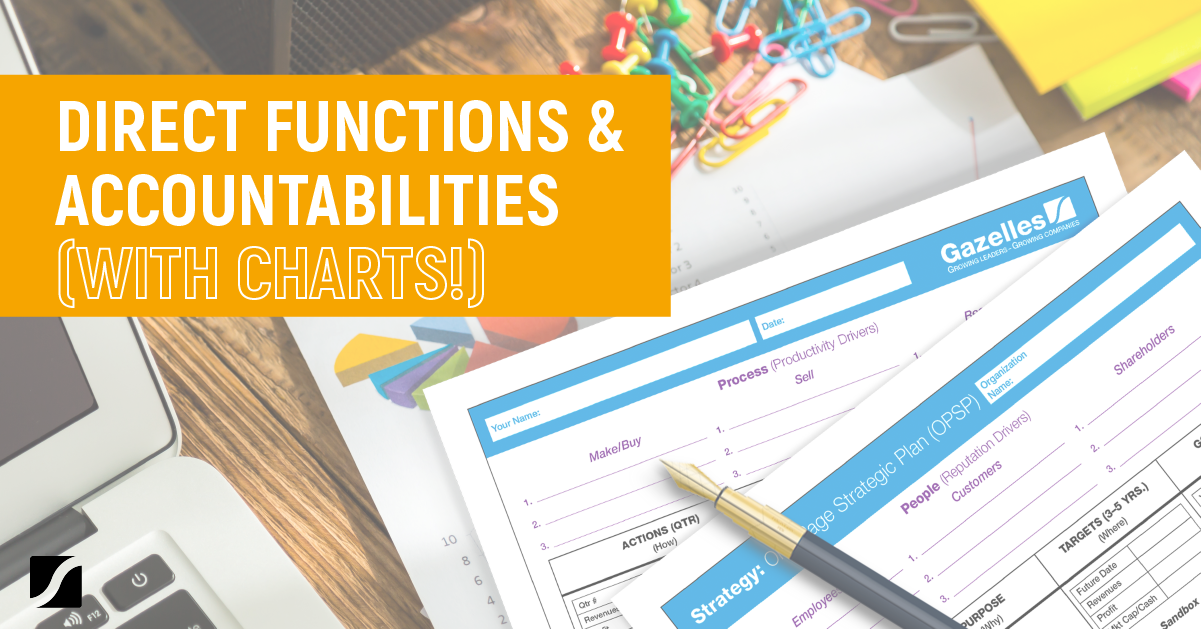How To Use A Simple One-Pager To Create A Culture Of Accountability
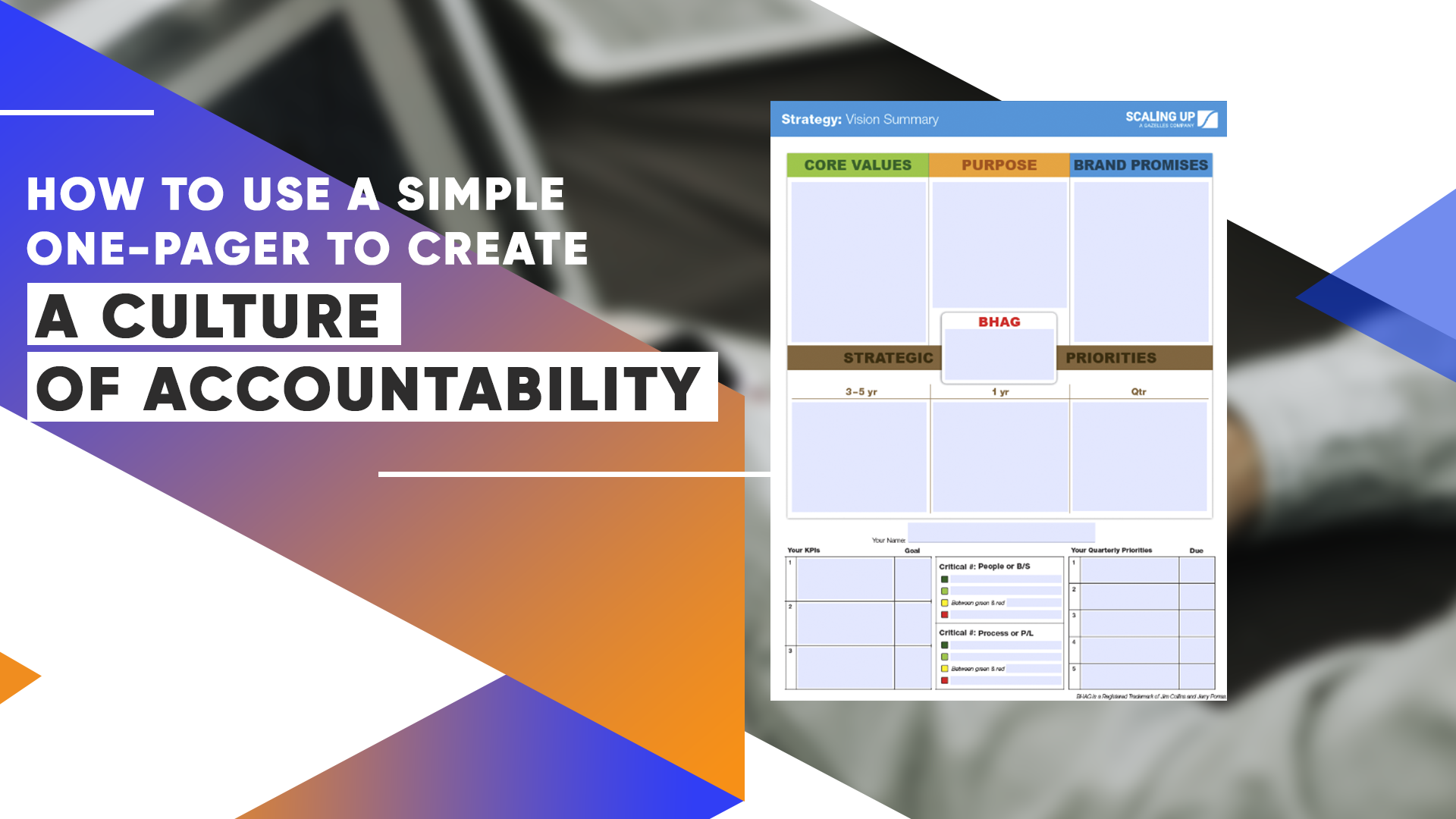
To grow fast, you need your whole team on board – dragging them along won’t work. If you want to scale up, each and every one of your team members needs to be equally committed to reaching your company’s KPIs.
But how do you create such a culture of accountability?
That’s the topic Richard Manders, serial entrepreneur and Certified Scaling Up Coach, and myself covered during our online Culture of Accountability Workshop.
You can only create a culture of accountability when individuals are openly held accountable, there’s no confusion about what they’re accountable for, and they’re willing to take full ownership of their own metrics and KPIs. The One-Page Strategic Plan and the One-Page Vision Summary from Verne Harnish’ proven Scaling Up methodology help you achieve this.
During the Culture of Accountability workshop, Richard and I shared:
- how you can shift the mentality of your employees from anxiety-based and problem-focused to passion-based and outcome-focused;
- the three disciplines for execution that enable you to build a culture of accountability;
- and how you can use the One-Page Vision Summary or OPVS to improve company-wide goal setting and increase individual commitment.
In this article, I’ll give you a summary.
Want to complete the One-Page Vision Summary and implement it right away? Download the OPVS template here.
Creating a Culture of Empowerment and Accountability – A Mentality Shift
Creating a culture of accountability is not something you can do by yourself because it requires a deep-rooted mentality shift throughout your company. What you can do, however, is provide the proper framework and tools and set the right example.
In order to help CEOs and business leaders scale up, there are a couple of things we use on top of Verne’s Scaling Up methodology that clients usually find helpful. And two of these invaluable techniques come from celebrated leadership expert David Emerald Womeldorff. They are replacing the Dreaded Drama Triangle with the Empowerment Dynamic and asking better questions.
Shifting from Dreaded Drama Triangle to Empowerment Dynamic
In the Dreaded Drama Triangle below you can see a visual representation of the victimhood mentality.
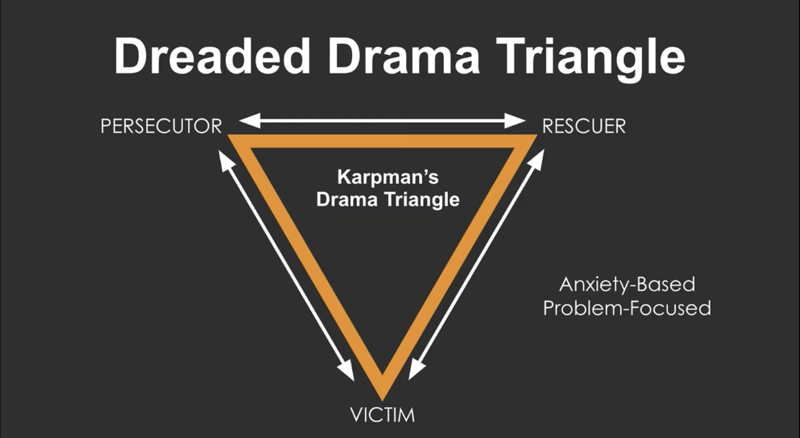
Whenever an obstacle arises, employees with this mentality may think: “There’s something persecuting me. I have a problem – involving a person or a situation – that I cannot fix. I am a victim and I need my boss to rescue me.”
So what happens then, is they’ll come to you and say: “Hey, you’re my boss. Tell me what to do. Fix it for me. Send them an email, give them a call, whatever you want, but you fix the problem.”
And if you do, that employee will feel great for a moment but you actually created a deeper problem: you told them you agree with them. By saving them, you’re basically saying: “Yes, you are a victim and you need me to save you.”
The more often you rescue your team, the more convinced they become that they are victims and the less likely it becomes that they will fix their own problems.
So how do you change this? By turning the triangle around in what’s called the Empowerment Dynamic:
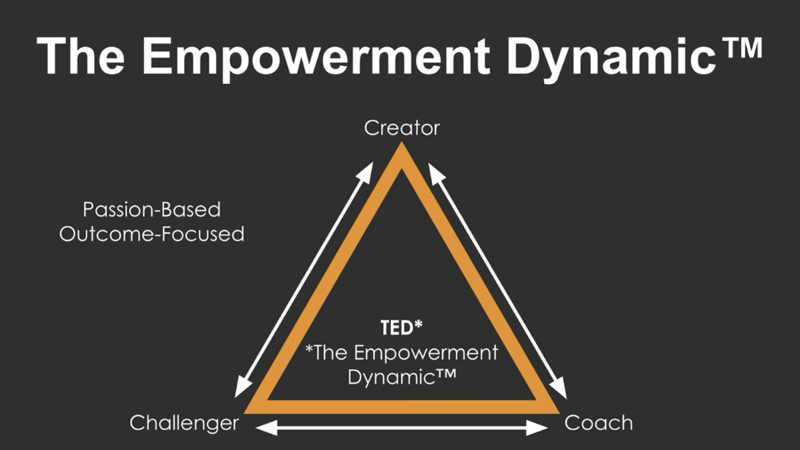
Following the Empowerment Dynamic, a leader says: “I am not going to fix it for you. I’m gonna coach you, so you can do it yourself. And also, we are not going to see it as a problem – we’ll see it as a challenge. It is part of what you have to do to grow.”
Whenever something is a problem, I don’t want to see it. I want problems to be removed and taken away from me. But if it’s a challenge, I’m excited to figure it out. Fixing something because it’s a challenge is something I want to do.
So in this new dynamic, your response is: “Hey, you’re a creator. I trust you. I hired you for this position because I know you can do it. So I’m not going to rescue you. I’m going to coach you but you’re going to do it.”
This way you create a mentality shift among your employees from being “victims” to being “creators.”
Becoming better at asking questions
In order to change the dynamic in your team as a business leader, you need to become better at asking questions. The goal – simply put – is to provide less answers and ask more questions.
In the example I gave during the workshop, I said imagine you're having lunch with a friend and he says he’s going to buy a Porsche but you know that’s not the right car for him. If you’ll just tell him: “Hey, don’t be dumb, you cannot afford a Porsche,” he may not listen or consider you a very good friend. But there are several types of questions you can ask that might change his mind. Like inductive, guiding, discovering or challenging questions:
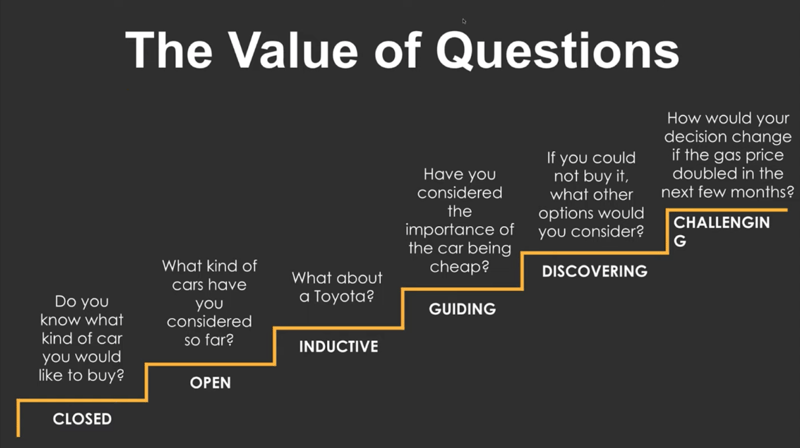
By asking the right questions, you can help your employees or team members see something in a different way. And when you pose challenging questions, you might even be able to change their mentality.
Getting your team ready to make disruptive decisions
This was one of the questions posed during the Q&A of the workshop: how do you increase confidence and courage? Since it’s related to creating a mentality shift, I’m summarizing the answer here:
Confidence and trust have to be developed; they’re like muscles that have to be trained.
First, you have to make a commitment: you always start with that. Those are reflected in your KPIs (which we’ll take a closer look at below in the 3 disciplines of execution).
I gave the example of committing yourself to running a marathon:
Let’s say my goal is to run a marathon in less than 3 hours. Now, I am going to train each day, eat better, sleep better, maybe read a book about running, etc. Because I am fully committed to the goal, I am going to develop the capabilities that are needed to reach it. I am going to muster the courage to make changes to gain trust in my own abilities.
Then, the next time, I can set an even more courageous and challenging goal, like run that marathon under 2.75 hours.
It’s the same in business: first you set your KPIs, then you come up with your priorities, you develop your capabilities, you gain trust, you reach your breakthroughs, and then you set bigger goals the next time.
But now that you know how to create a mentality shift, it’s time to focus on the next important part: execution. How can you make things happen?
Building a Culture of Accountability with the 3 Disciplines of Execution
The more structure we add to our organization, the more we reduce drama in our daily business operations. That’s why the most important thing we need to improve our execution is routine.
However counterintuitive this may sound to some: routine sets you free. It also gives your team members peace of mind and clarity and they need all of this to be able to focus and help you effectively scale your business.
With Scaling Up, you learn three disciplines for execution that help you build a culture of accountability. These are: setting priorities, gathering data, and establishing a meeting rhythm.
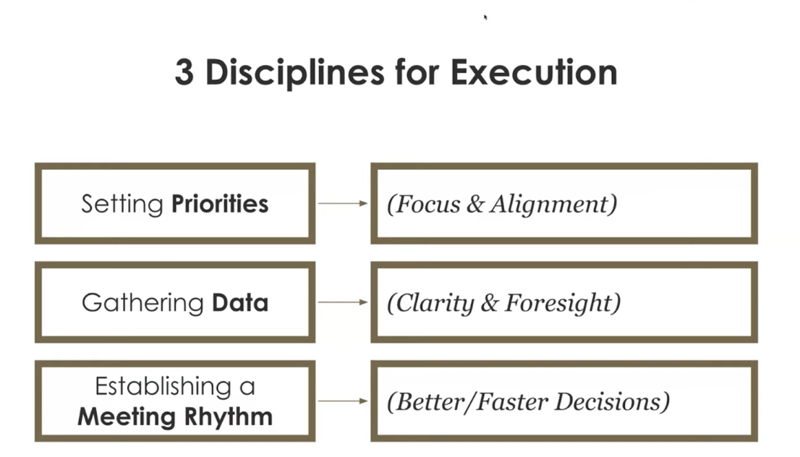
Setting priorities
If you want a culture of accountability, you have to start by making a commitment: what are the goals or KPIs your company has to accomplish in order to be successful?
This is what you put on top of your One-Page Strategic Plan and your One-Page Vision Summary. These could be revenue goals, profit, number of clients, number of hires, etc.
Based on these KPIs you determine your priorities.
As Richard clarified during the workshop: to help your team come up with their KPIs and priorities, ask them to think about it this way: what’s the end result of the efforts that you’re undertaking on a daily basis? These are your KPIs – the numbers that indicate that your job is going well. Your priorities are the things you're doing to reach those KPIs even faster.
Start with the priorities you need to focus on to hit your 3 year targets. Then, narrow these priorities down to the ones you’ve got to focus on to achieve your 1 year goals and narrow these down to the priorities for this quarter. Lastly, you can turn your quarterly priorities into individual ones.
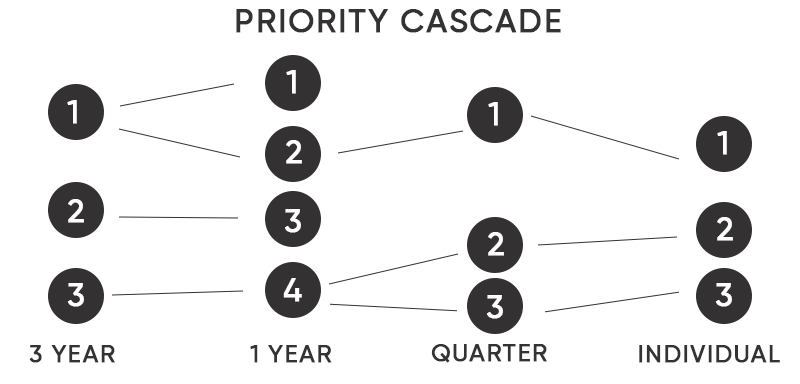
Most of what people are working on should be aligned with the company goals, so this cascade should make up about ⅔ of your 3 year targets.
Based on the company-wide KPIs, you can define 3-5 priorities for each of your teams. For instance: if your goal is to get from 8 to 10 million in revenue and you need 5 more sales agents to reach that goal, one of your team’s priorities would be to hire new sales agents.
The next step is to assign a person who’s accountable for each priority and determine the success criteria.
Gathering data
To stay on top of your goals, you need two types of metrics: future indicators and past indicators.
- A past indicator answers: what was the result of our efforts?
- A future indicator answers: how can we measure our effort and attitude to get things done?
Richard explained during the workshop that past indicators are often more easily identified than future indicators: income statements, cash flow, and accounting systems are all examples of past indicators. But where do you look for future indicators?
If you’re acquiring a customer and you’d map out all the efforts, most of them usually aren’t measured in anything financial. That’s why you will need a CRM system to gather this data properly. The number of sales calls, inbound leads or requested demos could be future indicators for instance. Even the amount of site visitors, or downloads of whitepapers could be measured and tracked as future indicators.
A clear example of both indicators for a sales team, could be:
- Past: number of contracts signed
- Future: number of generated proposals
In manufacturing good future indicators could be safety records, such as time between injuries, failure rates, and quality percentages.
The higher up in the hierarchy of the organization you find yourself, the more past (or results) oriented you will evaluate your job. The more you find yourself in the frontline, the more future (or effort) oriented your metrics will be. But since it’s impossible to drive a car by looking through the rear-view mirror only, you will need a balance.
Once you know your priorities and indicators, you can define your success criteria. When will you consider your job on or off track?
The easiest way to report on this is by creating a dashboard with a visual representation of your success criteria, like the one below.
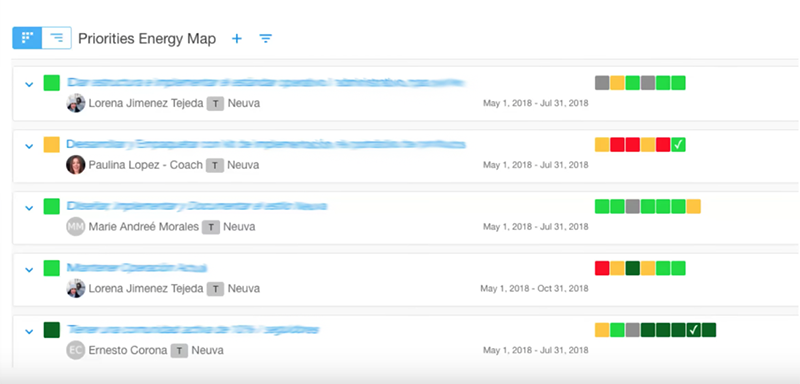
- Green = on track hitting your goals
- Super green = surpassing your goals
- Yellow = below goal/in progress
- Red = below acceptable
This example illustrates how easy it is to get insights into your company’s progress with such a dashboard. You can create one with the 5 top priorities in the company. This enables you to assess in under 5 seconds which areas of your business need your attention.
As Richard suggested during the webinar, another great advantage of this dashboard is that you can focus only on the things that are either yellow or red during your meetings. There is no need for reporting on the greens, so you can save a lot of time.
Establishing a meeting rhythm
Meetings are important for synchronization. They help you accelerate your business, ensure teamwork, and heal/improve relationships.
I like to consider meetings your pulse. The faster your pulse, the faster you can move.
The meeting rhythm we suggest with Scaling Up is (1) a daily meeting or huddle of 15 minutes for quick synchronization, (2) a weekly meeting of 60-90 minutes for focus and alignment, (3) a monthly meeting of 4-8 hours to discuss in detail, (4) a quarterly meeting of 1-2 days with a coach to come up with the right priorities and critical numbers and (5) an annual strategy meeting of 2 days to plan ahead.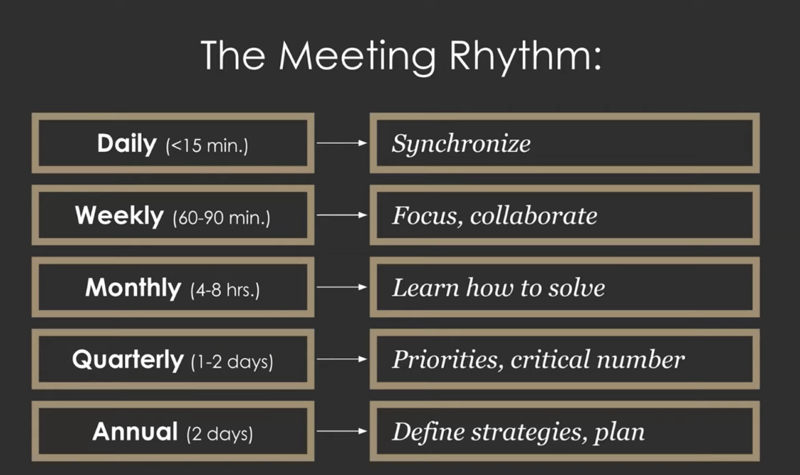
The rest of the time you will be able to focus on executing.
If you’re unsure who needs to meet with whom in which meeting, Richard’s advice during the workshop was to get out your org chart and draw circles.
Clients often question whether or not they have to implement the meetings.
Although we are obviously biased, we’d say at least start with the daily huddle. Tomorrow!
Start seeing each other face-to-face every day to get into the cadence and you’ll notice how much value you’ll derive from just 10-15 minutes a day.
And you don’t have to wait until you have everything figured out either. Just gather your team members and give everyone a 1 minute update:
- What’s your top priority for the day?
- What news do you have for the good of the whole team?
- Who needs help?
You can also immediately try this power of accountability exercise: “I don’t need to talk to you when you’re in the green.” – only meet with team members when there are actual challenges to discuss.
Completing the One-Page Vision Summary (OPVS)
Execution changes dramatically when you’re able to communicate your top priorities more clearly throughout your organization. The One-Page Strategic Plan helps you to accomplish this but not everyone may need or understand all the information that’s presented on the OPSP.
Hence, to effectively distribute your strategic plan throughout your entire organization, you may want to use the One-Page Vision Summary or OPVS instead. Because, like Richard said during the workshop: “Taking all the people that are operating loosely and getting them to sign up for priorities and metrics is hard. But it is the most important thing to do to get your company to the next level of growth.”
The reason why the One-Page Vision Summary is so powerful is that it helps you to get people to create their own goals and metrics. Themselves. And this is key in creating a culture of accountability.
At the top of the OPVS you can find the core of who you are as a company: your core values, purpose, brand promise, and BHAG. Here you paint the bigger picture: why are we here?
In the second part you get more granular: this is what you’re going to do to get there.
Once you have filled in the company-wide strategic priorities for the next 3 years, the year ahead, and the upcoming quarter, it’s time to sit down with every team member and ask them: “What are your individual priorities to reach which goals and what are your success criteria?”
If you go to University it’s very clear what you need to do to get an A. The OPVS helps your employees to craft their own report card, so they can self manage and understand that when they get in trouble, they simply need a hand.
Taking the time to individually discuss each objective with your team members is important because you want them to take full ownership. Let them decide their own number so they will commit to it 100%.
Human beings often overestimate what they can do in the short-term but they underestimate what they can do in the long-term. That’s why most of them will give you a bigger number than you had in mind but with the ones that don’t, you can negotiate.
Everyone gets a score card. You just need to get the messaging right and manage them through the process. This way, everyone can own their own stuff.


![[OPVS] Horizontal-2](https://blog.growthinstitute.com/hubfs/%5BOPVS%5D%20Horizontal-2.png)

